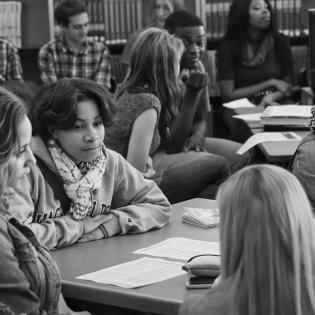UN's Sustainable Development Goals
Young people learn about global efforts for universal mandatory education and equity for girls in school.
The learner will:
- identify countries without universal primary education.
- read and summarize goals related to education and gender equality in UN’s Sustainable Development Goals.
- describe the barriers to educating all children in developing countries.
- share their opinions and ideas verbally and in writing.
- participate in raising awareness and funds for schools that lack basic resources.
- Internet access and projector to display UN Sustainable Development Goals
- Chart paper for group notes
- developing countries: countries with low levels of material well being
- global: related to issues across the globe – a perspective that takes into account the interconnectedness of people, countries, and institutions from across the world.
- gender disparity: the unequal treatment of males and females, often referring to girls/women having fewer opportunities than boys/men
- goal: the terminal point of a journey or deed
- What did you discover about education in the world? In your community? For yourself?
- What might life be like for someone who does not have access to school?
- What do you want for the girls in areas where there is not mandatory primary education? What do you think they want for themselves?
Instructions
Anticipatory Set:
Display the website for the UN’s Sustainable Development Goals. Read about the background and goals online or in the Learning to Give mini-course. Introduce the Sustainable Development Goals and focus on the goals related to education and gender equality.
The 17 Sustainable Development Goals grew out of the United Nation’s Millennium Development Goals. In late 2000, leaders from all over the world adopted the “United Nations Millennium Declaration, committing their nations to a new global partnership to reduce extreme poverty and setting out a series of time-bound targets - with a deadline of 2015” (United Nations, n.d.).
Read over the fourth and fifth goals (below) relating to universal primary education and gender equity.
Goal Four: As the world's population grows, more resources and policies are needed to make sure that students everywhere get a good education. The world needs two million teachers and four million new classrooms to make sure every student can get an education. Full access to quality education is the first step to achieving sustainable development, poverty eradication, gender equality and women's empowerment. Let's make the sound investment in quality education by ensuring that primary and secondary schools are free for every child by 2030.
Goal Five: Gender inequalities are still deeply rooted in every society. Many women still lack access to employment opportunities, basic education, and healthcare, and they're often subjected to violence and discrimination. The math is simple: in countries where there's higher equality, there's less poverty, more economic growth, and a higher standard of living. Let's improve opportunities for everyone by dismantling barriers to women's participation in economic, social and political life.
Through internet research, they identify countries that have not reached these goals.
Discuss:
- Whose responsibility is it to improve schools in developing countries?
- How do you think quality education affects your neighborhood? The whole country? The whole world?
- What else do you want to know about this issue or topic?
Then show how young people can get involved in helping to reach the goals here: Voices of Youth: https://www.voicesofyouth.org/
Ask if they have heard the phrase, “Do to others what you want them to do to you.” Discuss their feelings about it. Then ask them what they think of the phrase, “Do to others what they want done to them.” Discuss how the phrases differ and which they like better. How does that phrase relate to taking action for girls in developing countries?
Youth plan a project to raise awareness of the need for universal primary education. This may be a creative effort to raise awareness of a need and call to action.
Philanthropy Framework
-
Strand PHIL.I Definitions of Philanthropy
-
Standard DP 01. Define Philanthropy
-
Benchmark HS.1 Define philanthropy to include giving and sharing; volunteering; and private individual action intended for the common good. Explain how a volunteer individual/group can act for the common good.
-
-
-
Strand PHIL.II Philanthropy and Civil Society
-
Standard PCS 01. Self, citizenship, and society
-
Benchmark HS.3 Give examples of human interdependence and explain why group formation is one strategy for survival.
-
-
-
Strand PHIL.III Philanthropy and the Individual
-
Standard PI 01. Reasons for Individual Philanthropy
-
Benchmark HS.1 Define and give examples of motivations for giving and serving.
-
-
-
Strand PHIL.IV Volunteering and Service
-
Standard VS 01. Needs Assessment
-
Benchmark HS.1 Identify a need in the school, local community, state, nation, or world.
-
-
Standard VS 02. Service and Learning
-
Benchmark HS.1 Select a service project based on interests, abilities, and research.
-
-
Standard VS 03. Providing Service
-
Benchmark HS.1 Provide a needed service.
-
-
